

I.Three-dimensional multi-phase simulation of proton exchange membrane fuel cell
Water and thermal management is an important factor limiting its performance and durability, which is related to gas and liquid two-phase flow, water evaporation and condensation, membrane water relase and absorption, gas species transport, electrochemical reations, proton and electron transport and heat transfer, etc. These highly coupled tranpsort phenomena make water and thermal management very complicated. Three-dimensional multi-phase model is helpful in deeply understanding the multi-phase transport coupled with electrochemical reactions in fuel cell, which is of great significance to cell design and optimization. After comprehensive validation, the effect of 3D fine mesh and porous media flow fields on fuel cell peroformance is investigated carefully using this model.

Figure 1. Schematic of fuel cell stack

Figure 2. Schematic of fuel cell model

Figure 3. Schematic of 3D fine mesh flow field
II. numerical investigation of proton exchange membrane fuel cell system
Including stack, gas supply subsystems, humidification subsystem, and heat management subsystem. The transient multiphase stack model, membrane humidifier model, air compressor model with control strategies, hydrogen recirculation model, and radiator model are involved. The research objectives are divided into three aspects:
1. Stack performance prediction and structural design. The uneven reactant distribution among individual fuel cells is considered. The stack flow distribution model is subsequently coupled with the pseudo two-dimensional stack model to develop a comprehensive multi-dimensional multiphase stack model. The steady-state and transient performances are simulated. The operating conditions, gas flow patterns, stack layout configuration, and cooling channel designs are optimized.
2. Heat and water management at the system level. The energy flow inside the whole system is analyzed, and the operating conditions are optimized. The system designs are also optimized, such as the selection of hydrogen recirculation devices and appropriate arrangement. The cold start performance of the system is investigated, including self-startup capacity and assisted startup strategies.
3. Dynamic response and control strategy at the system level. The dynamic responses of all subsystems under typical operating conditions are investigated. Some effective control strategies are proposed and validated. The fault diagnosis system is summarized.
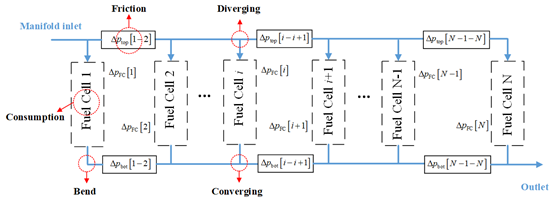
Figure 1: Schematic diagram of the stack flow distribution model
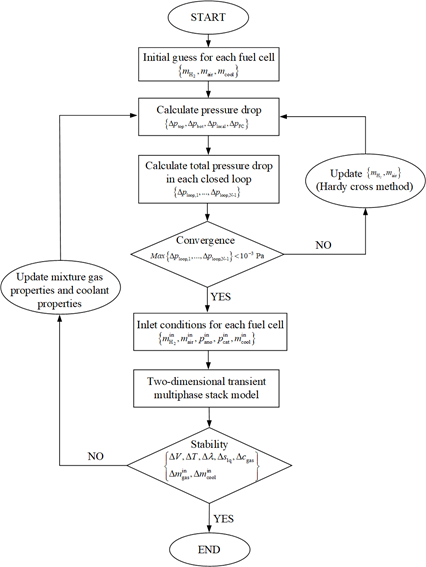
Figure 2: Calculation procedure of the multi-dimensional stack model
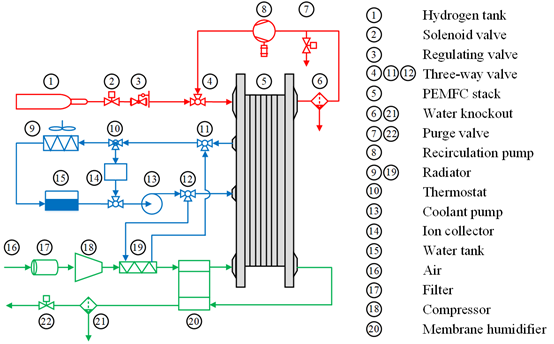
Figure 3: Schematic diagram of the PEMFC system
III.SOFC one-dimensional steady-state model/quasi-two-dimensional numerical model
1.Modeling and optimization of electrode structure design for solid oxide fuel cell
A comprehensive steady-state model is developed to investigate the effects of electrode structure on the performance of solid oxide fuel cell, considering detailed heat and mass transfer processes, as well as electronic and ionic charge transport. The percolation theory is used to evaluate the effective transport properties in electrode. The uniform and non-uniform distributions of electronic/ionic conducting materials in anode/cathode function layer (AFL/CFL) are comprehensively compared. The effects of function layer thickness and particle sizes are found to be different in anode and cathode. The optimal AFL thickness is increased with the increment of particle sizes. The results show that the optimal AFL thickness ranges from 5 µm to 30 µm with relatively small particle sizes (<0.4 µm), while the cell performance keeps increasing with relatively large particle radius when the AFL grows thicker. Although there exists slight performance drop in condition of non-uniform distribution, the structure reduces ionic-conducting material dosage and fabrication difficulty and it provides another alternative microstructural design which is meaningful to fuel cell optimization.
2.Global sensitivity analysis of uncertain parameters based on 2D modeling of solid oxide fuel cell
In this study, an enhanced non-isothermal quasi-two dimensional mathematics model of solid oxide fuel cell has been developed to investigate the parametric variations effects of fuel cells, which consider detailed heat and mass transfer as well as charge transport process. Effective properties are completely dependent on microstructures parameters in electrodes. Besides, we propose an elementary effect (EE) approach based on Monte Carlo experiments that enable us to comprehensively evaluate parametric sensitivity index of total 24 parameters which are finally categorized into different sensitive levels. A two sample Kolmogorov-Smirnov (K-S) test is employed to carry out feasibility assessment of elementary effects thus demonstrate the ability of EE method to perform robust and accurate sensitivity analysis. All our sensitivity analysis results throw light on the mechanism of parametric variation influence on cell performance. The investigation emphasizes the importance of microstructural parameters at anode/cathode function layers (AFL/CFL). With this research, relative volume fraction of conducting material at AFL/CFL is the most sensitive factors among all input parameters while particle radius is the least sensitive microstructural parameters. It is revealed that performance gains are limited if merely change ionic and electronic particle size simultaneously. Particle radii ratios which represents the relative size of electronic and ionic particles is found to be much more sensitive than particle size by ways of affecting ohm loss. Cathodic electrochemical parameters reflect cell performance more significantly than anodic factors. To further elucidate the role of input factors, the present study provides a principle for sensitivity classification of input parameters as well. Besides, impacts of current density variation on parametric sensitivity are comprehensively taken into account. Negative or positive effects of parameters on cell performance and their mechanism of action are also discussed. Furthermore, sensitivity analysis of single parameters at different position is conducted to assess the probability of structural optimization along the channel length. Then a feasible non-uniform distribution method at function layers is proposed for further improvement of cell performance according to single parametric SA results along the channel direction.
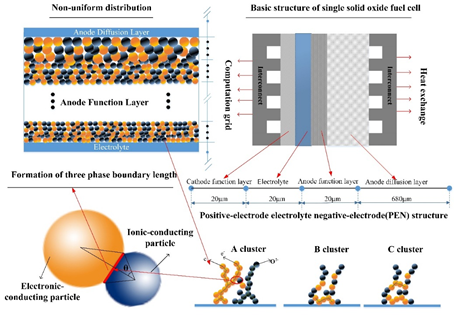
Figure 1 Illustration of the one-dimensional model geometry including micro-scale and macro-scale structures of solid oxide fuel cell
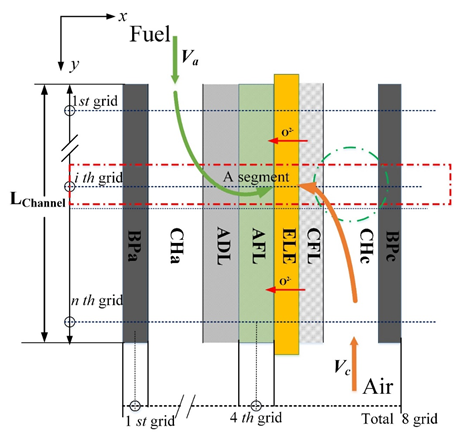
Figure 2. Illustration of 2D anode support solid oxide fuel cell structure
IV.Three-dimensional modeling of SOCs
For the various physical fields within SOCs, such as velocity, temperature, concentration and chemical/electrochemical reactions, we established a three-dimensional model utilizing the CFD method. The model considers the involvement of different hydrocarbon fuels in chemical and electrochemical reactions. Then, the internal physical fields are simulated and discussed in detail at the cases of partly pre-reformed gas and syngas. In addition, the cell performance and temperature distribution, with a view to various fuel utilizations, air ratios and flow configurations at different pressures, are investigated to elucidate the factors influencing temperature. This model can provide reference for cell structure design and optimization and can deeply analyze the internal heat and mass transfer and CO2 enrichment mechanism. In addition, the effects of fuel gas, electrode, channel design, thermal management and load change on macroscopic performance are clarified.
V.Investigation of the coupled physical-electrochemical processes in the electrode of fuel cell
The research interest mainly focuses on the multiphase and reactive transport phenomena in the electrode of fuel cell. Research aims to optimize the electrode design by understanding the mechanism of the transports. So far, Research has developed a whole electrode investigation system, including porous structure reconstruction models for GDL, MPL and CL and efficient-parallel versatility LBM models based on GPU to realize large scale simulation.

Figure 1. GDL reconstruction process

Figure 2.Two phase flow in the GDL

Figure 3.CL reconstruction process

Figure 4.Novel CL structure design

Figure 5.The novel CL can highly improve the electrode performance
VI.Modeling for cold start process of PEM fuel cell ; Modeling for PEM fuel cell stack
Research interests focus on water and thermal management of proton exchange membrane fuel cell and I develop two dimensional multiphase PEM fuel cell models for normal operation and cold start process. For the consideration of improving the hydrogen utilization during the operation, proton exchange membrane (PEM) fuel cells with a dead-ended anode (DEA) or an off-gas recirculation anode (ORA) are widely adopted. However, those two modes may cause the anodic water and nitrogen accumulation in comparison with the flow-through anode (FTA) mode, resulting in significant performance degradation. A two-dimensional transient multiphase mathematical model is developed with detailed consideration of water phase changes and nitrogen crossover phenomenon. The current density distribution along the flow channel is calculated by a simplified electrochemical model. The simulation results agree well with the experimental data at both subzero temperatures (-7℃ and -9℃) and normal operating temperatures (70℃). The effects of hydrogen flow managements (FTA, DEA, ORA), flow configurations (co-flow and counter-flow), and startup strategies (constant current and constant voltage) are investigated during the startup process from subzero to normal operating temperatures. It is found that much less ice is generated in counter-flow cases compared with co-flow cases during the constant current startup process. A relatively lower startup voltage (e.g. 0.3 V) inhibits the nitrogen crossover and corresponding anodic nitrogen accumulation in both ORA and DEA modes. The ORA mode is found the best hydrogen flow management owing to higher hydrogen utilization efficiency, higher anodic nitrogen tolerance, better output performance and better startup capability. Relative research about the strategies for ORA mode has been done in papers written by other co-authors and me.

Figure 1. Schematic diagram of 2D PEM fuel cell model in counter-flow configuration.

Figure 2. Algorithm of the numerical solution.

(a)

(b)
Figure 3. (a) Comparison of output and ohmic resistance voltage time evolutions of PEM fuel cell at subzero startup process between simulation and experiment.
(b) Comparison of cell polarization curves on different conditions between simulation and experiment.

(a)

(b)
Figure 4. Evolutions of output voltage with three hydrogen flow managements in (a) co-flow mode and (b) counter-flow mode.
VII.Development of a quasi-2D transient model of proton exchange membrane fuel cell (PEMFC) and numerical investigation of the characteristic of PEMFC with anode recirculation.
The quasi-2D transient model is developed based on the internal transport mechanism of the PEMFC which can simulate the startup, transient current operation and shutdown process. The input includes the operating conditions, like current density (or voltage), operating temperature, inlet pressure, stoichiometry, and PEMFC design parameters and material parameters. The output includes the time transient of internal physical quantities, including voltage, local current density, ohmic resistance, activation loss, temperature, membrane water content, relative humidity, hydrogen, oxygen concentration, etc. We also used the model to simulate the characteristic PEMFC with anode circulation, including nitrogen crossover and buildup in the anode and self-humidification effect. Furthermore, we done numerical investigation on anode purging process to purge nitrogen in the anode, and two purge strategies are presented: voltage-based and nitrogen- based.
VIII.Direct Numerical Simulation of Multiphase Flow and Multi-component Transfer in the PEMFC
The multi-phase flow and multi-component transfer in the proton exchange membrane fuel cell (PEMFC) significantly affects cell performance.Niu Zhiqiang’s research interests focus on the multi-component multiphase flow in the channel and gas diffusion layer via three techniques: direct turbulence numerical simulation (DNS), microstructure reconstruction of gas diffusion layer, and three-dimensional PEMFC model based on open source CFD platform. The main conclusions have been obtained such as the fundamentals of gas-liquid two-phase flow in turbulent and laminar flow, the reconstruction method of gas diffusion layer and X-ray tomography, the dynamic behavior and distribution characteristics of liquid water, and the modeling procedures of three-dimensional PEMFC model based on Open FOAM platform.
IX.Numerical study of two-phase flow in foam material and three-dimensional (3-D) flow field
Foam material is a kind of functional material, generally used as the distributor of mass, electron and heat of PEM fuel cell. The conventional reactant distributor is the channel-rib structure etched on the bipolar plates whose inherent drawbacks can hardly be avoided. The progress on foam material provides new ideas for channel/flow field design. However, only few experimental or numerical studies have been carried out on metal foam (MF) flow field. The heat and mass transfer mechanism are still unclear, especially for the two-phase behaviors.
At present, many of the reconstruction methods of MF flow field are based on polyhedron cell assumption. The method has been verified effective on the two-phase flow of MF flow field under limited computational cost. Another method is based on X-ray computational tomography (CT). After the postprocess of CT, a geometric profile can be obtained, based on which the MF model is reconstructed. But this method is costly and can not control the porosity and cell density accurately. Thus, it is efficient for the study of two-phase flow with different external conditions, but not the effect of its own properties on two-phase behaviors.
In addition, international scholars have proposed a new baffled flow field. And the most representative one is the 3-D fine mesh flow field utilized in the fuel cell vehicle Mirai manufactured by Toyota. The baffle with shape of fish scale can guide the air and water simultaneously, and has good mechanical strength and electrical conductivity. It has been regarded one of the potentials of high-performance flow field.
Bao Zhiming’s research field is the multi-phase flow analysis and flow field design of PEM fuel cells. Through the volume of fluid (VOF) method and Open source software Open FOAM, I have studied the liquid behaviors and two-phase characteristics of various flow fields. Based on above researches, I am supposed to provide useful suggestions on flow field design and water management strategy.
X.Molecular Dynamics Simulation of Catalyst layer
Catalyst layer (CL) provides the sites for electrochemical reaction in proton exchange membrane (PEM) fuel cell. Generally, CL consists of catalyst, catalyst support, electrolyte and so on, where the complex structure and transport phenomena exist. However, these phenomena are difficult to be experimentally observed due to such little scale (about several nanometers). So we adopt the molecular simulation to investigate the effects of key parameters (such as the catalyst material, structure and loading, electrolyte molecular structure and loading, etc.) on the CL microstructure, the mechanism of transport phenomena in CL (such as proton migration, oxygen transport through ionomer, water molecules status, ice formation, etc.), the relationships between structure and transport phenomena. And the research aims to provide theoretical fundamental for material development and structure design of CL. In addition, we also investigate the structure, transport and thermal conductivity of proton exchange membrane.
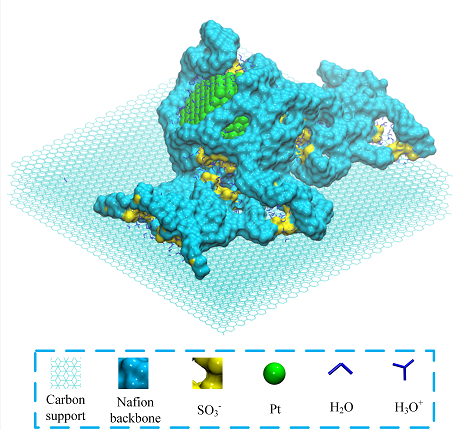
Fig. 1. Schematic of CL
Address:Building 34, Tianjin University, Jinnan District, Tianjin
E-mail:kjiao@tju.edu.cn
 WeChat
WeChat
